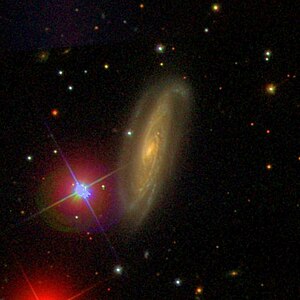NGC 296
| Galaxy NGC 296 |
|
|---|---|

|
|
| SDSS recording | |
| AladinLite | |
| Constellation | fishes |
|
Position equinox : J2000.0 , epoch : J2000.0 |
|
| Right ascension | 00 h 55 m 07.5 s |
| declination | + 31 ° 32 ′ 32 ″ |
| Appearance | |
| Morphological type | SBb |
| Brightness (visual) | 12.4 mag |
| Brightness (B-band) | 13.2 mag |
| Angular expansion | 2.2 ′ × 1 ′ |
| Position angle | 164 ° |
| Surface brightness | 13.1 mag / arcmin² |
| Physical data | |
| Affiliation | WBL 20 |
| Redshift | 0.018199 ± 0.000023 |
| Radial velocity | 5456 ± 7 km / s |
|
Stroke distance v rad / H 0 |
(251 ± 18) x 10 6 ly (76.9 ± 5.4) Mpc |
| history | |
| discovery | Wilhelm Herschel |
| Discovery date | September 12, 1784 |
| Catalog names | |
| NGC 296 • UGC 562 • PGC 3260 • CGCG 501-042 • MCG + 05-03-024 • IRAS 00523 + 3116 • 2MASX J00552153 + 3140382 • GC 167 • H II-214 • LDCE 0074 NED009 | |
NGC 296 is a faint barred spiral galaxy of the Hubble type S0 / a in the constellation Pisces on the ecliptic . It is estimated to be 251 million light years from the Milky Way and about 160,000 light years in diameter.
The object was discovered on September 12, 1784 by the German-British astronomer Wilhelm Herschel .
Occasionally, NGC 296 is inappropriately associated with the nearby galaxy PGC 3274 and then PGC 3260 is associated with the galaxy NGC 295 . This interpretation is based on a mistake Ralph Copeland made in describing the position of NGC 295 with respect to NGC 296. He presumably observed other galaxies that could not yet be assigned because no pair in the area fits his description. The object NGC 295 is therefore considered missing for its description.
